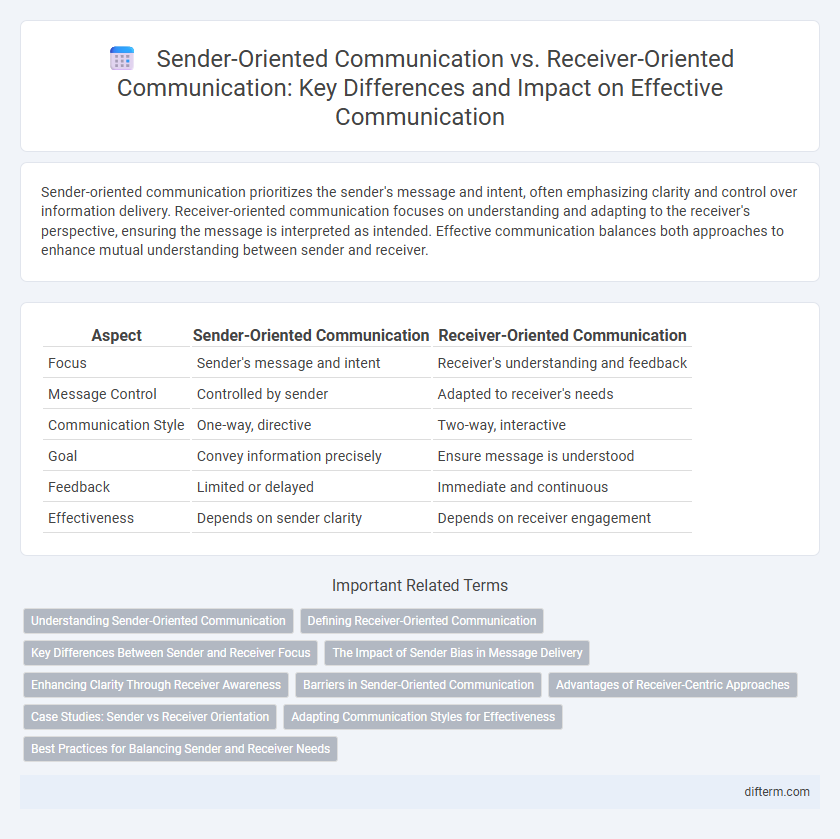Sender-oriented communication prioritizes the sender's message and intent, often emphasizing clarity and control over information delivery. Receiver-oriented communication focuses on understanding and adapting to the receiver's perspective, ensuring the message is interpreted as intended. Effective communication balances both approaches to enhance mutual understanding between sender and receiver.
Table of Comparison
| Aspect | Sender-Oriented Communication | Receiver-Oriented Communication |
|---|---|---|
| Focus | Sender's message and intent | Receiver's understanding and feedback |
| Message Control | Controlled by sender | Adapted to receiver's needs |
| Communication Style | One-way, directive | Two-way, interactive |
| Goal | Convey information precisely | Ensure message is understood |
| Feedback | Limited or delayed | Immediate and continuous |
| Effectiveness | Depends on sender clarity | Depends on receiver engagement |
Understanding Sender-Oriented Communication
Sender-oriented communication centers on the sender's intent, message clarity, and delivery style, emphasizing how the information is structured and transmitted. This approach prioritizes the sender's perspective, often assuming the audience's comprehension without adapting to their feedback or needs. It is crucial in contexts where the sender's control over the message is paramount but may risk misinterpretation if receivers' viewpoints are overlooked.
Defining Receiver-Oriented Communication
Receiver-oriented communication prioritizes the needs, preferences, and understanding of the receiver, ensuring messages are tailored for clarity and relevance. It involves active listening, empathy, and feedback mechanisms to enhance message comprehension and engagement. Effective receiver-oriented communication reduces misunderstandings and fosters meaningful connections in personal and professional interactions.
Key Differences Between Sender and Receiver Focus
Sender-oriented communication emphasizes the clarity, structure, and intent of the message crafted by the sender, prioritizing how information is delivered. Receiver-oriented communication prioritizes understanding, interpretation, and feedback from the recipient, ensuring the message aligns with their context and perspective. Key differences include the sender's focus on message formulation versus the receiver's focus on message comprehension and response.
The Impact of Sender Bias in Message Delivery
Sender-oriented communication often results in message distortion due to the sender's preconceived biases, which influence tone, word choice, and emphasis. These biases can lead to misinterpretations, reducing the effectiveness of the message by prioritizing the sender's perspective over the receiver's comprehension. Receiver-oriented communication mitigates this risk by tailoring messages to align with the receiver's context and expectations, ensuring clearer understanding and engagement.
Enhancing Clarity Through Receiver Awareness
Enhancing clarity in communication requires shifting focus from sender-oriented methods to receiver-oriented strategies, ensuring messages are tailored to the audience's knowledge and context. Receiver awareness allows for adapting language, tone, and content complexity, reducing misunderstandings and increasing message retention. Prioritizing this approach leads to more effective information transmission and stronger interpersonal connections.
Barriers in Sender-Oriented Communication
Sender-oriented communication often faces barriers such as message distortion due to biased encoding, lack of feedback mechanisms, and assumptions about the receiver's knowledge or perspective. These obstacles result in misinterpretations, reduced message clarity, and ineffective information transfer. Overcoming these barriers requires focusing on receiver feedback and adaptive messaging strategies to ensure accurate understanding.
Advantages of Receiver-Centric Approaches
Receiver-oriented communication enhances message clarity by prioritizing the audience's preferences, background, and needs, reducing misunderstandings and increasing engagement. It fosters stronger relationships as the sender adapts the tone, style, and content to resonate with receivers, facilitating effective feedback loops. Emphasizing empathy and active listening in receiver-centric approaches leads to improved information retention and collaborative problem-solving.
Case Studies: Sender vs Receiver Orientation
Case studies reveal that sender-oriented communication often prioritizes message clarity and completeness, yet may neglect the receiver's context and interpretation, leading to miscommunication. Receiver-oriented communication emphasizes understanding the audience's needs, preferences, and feedback, resulting in higher engagement and message retention. Effective communication strategies balance sender intent with receiver perception, optimizing information exchange in diverse settings such as marketing, education, and organizational communication.
Adapting Communication Styles for Effectiveness
Adapting communication styles for effectiveness involves shifting from sender-oriented communication, which focuses on the clarity and completeness of the message, to receiver-oriented communication that prioritizes audience understanding and engagement. Tailoring language, tone, and delivery methods to the receiver's preferences enhances message retention and reduces miscommunication. Utilizing feedback mechanisms and empathetic listening further refines communication strategies to align with receiver needs, boosting overall interpersonal effectiveness.
Best Practices for Balancing Sender and Receiver Needs
Effective communication balances sender-oriented clarity with receiver-oriented empathy to ensure messages are both clear and engaging. Employing active listening techniques and feedback loops helps align sender intentions with receiver interpretations, minimizing misunderstandings. Tailoring messages to audience context and preferences enhances comprehension and fosters meaningful interaction, promoting a dynamic exchange between both parties.
sender-oriented communication vs receiver-oriented communication Infographic

 difterm.com
difterm.com